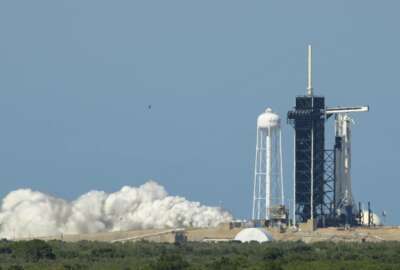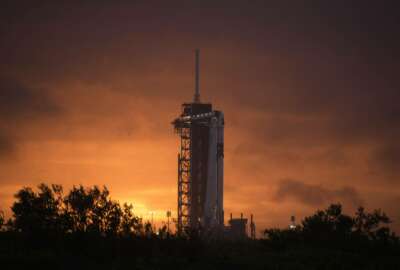
NASA looks to send astronauts to space station on private sector rocket
Today's the day NASA and the United States gain back the ability to launch astronauts into low earth orbit.
Update: Due to poor weather conditions, the launch has been postponed.
Best listening experience is on Chrome, Firefox or Safari. Subscribe to Federal Drive’s daily audio interviews on Apple Podcasts or PodcastOne.
Today’s the day NASA and the United States gain back the ability to launch astronauts into low earth orbit. Two of them will ride a private sector rocket to the International Space Station. For what it took to get to this point, NASA deputy administrator Jim Morhard spoke to Federal Drive with Tom Temin.
Interview transcript:
Tom Temin: Jim, good to have you back.
Jim Morhard: Tom, it’s great to be back with you. Thank you for having me.
Tom Temin: So tell us what’s going on. This is going to be taking place this afternoon in Cape Canaveral and no more having to take a taxi ride with the Russians.
Jim Morhard: Exactly. It was July 8, 2011 was the last time that we launched Americans from American soil into space. So nine years and you know, it really gets down to choices, and we’re at a crossroads today where, you know, the President has made a choice to go forward in space. And we’ve really got to start with regular human rated spacecraft flights from the United States. And when I say that, I’m talking about a crew transportation system. You know, we need to establish that to get to the moon, to get to Mars. You know, we also really need to really understand long durations on the International Space Station to really know whether it’s safe or not to be up there that long. But you know, our ultimate goal in this flight is safety, reliability, portability, and also really just being able to go back and forth to space with unfettered access. You think about this flight test, we call it an end to end flight test. The official name of it is demo two. And, you know, our ultimate goal is to get the crew back to their families safely. That’s our highest priority. Then you think about it, Tom, the most complex system on that spacecraft are the humans, so we’ll be most focused on them more than anything else, but it’s also vehicle safety. And then we’ve got to meet our objectives. And when I say that, we’re talking about the launch, talking about getting to orbit, docking with the space station undocking with it, deorbiting, reentry, and splashdown. You know, we haven’t had a splashdown since the last mission of Apollo. Most people haven’t been alive to know what a splashdown is like, and it can be heart stopping as we make sure that they come back through the atmosphere safely.
Tom Temin: Well, I’m old enough to remember some black and white so..
Jim Morhard: Yeah, me too. Me too. But with that, then we’ll recover them and get them back to the cake. But you know, you talk about the splashdown. It’s only happened with Mercury, Gemini and Apollo programs. So really is the fourth program in human history.
Tom Temin: NASA has a record with SpaceX on everything up to the crew capsule because they have taken payloads on their Falcon nine. So what’s new today is the crew capsule on top — correct?
Jim Morhard: Yeah, and you know, Tom, they’ve done a tremendous job. And they’ve really established a confidence in their abilities to launch commercial vehicles. This is the final flight test of what we call Crew Dragon, and that’s the capsule. But they’ve been using the Falcon nine rocket system for a long time, as you said, to deliver cargo to the station. So if all goes well, both the Crew Dragon capsule and the Falcon nine will be certified for regular crew flights to station. That’s the hope of this effort today. And again, this is about safety, its reliability, but it’s also a transformation to commercial human spaceflight. You think about NASA has always designed, developed, built and then done the operations of all spaceflight. And we’re getting to a point where we want this to be a commercial effort so that we’re at customer to US companies that are doing this work. The hope is we’ll be one of many customers, and it’s really about promoting the economy in low Earth orbit. That’s what we’re trying to do. And SpaceX is integral to doing that. We awarded a firm fixed price contract back in 2014, to both SpaceX and Boeing and they’ve competed to get to this day. Boeing’s not out of it. But SpaceX is going to be the first to be ready for certification. And they’ve just been tremendous partners all along the way. And it really starts with Elon and it goes down to a line worker. It was mentioned in what we call the flight readiness review last week. It started out as a partnership, and in many ways, it’s become a friendship.
Tom Temin: And you’re more than just a customer. It’s really more of a partnership in the sense that NASA contributed a lot of the development money. And I think you were quoted some time ago as saying that you almost saved two thirds of the cost had NASA had to develop this all on its own. So there was also private capital behind the SpaceX effort.
Jim Morhard: Yeah, we certainly put in a number of billions of dollars to this effort, but they’ve put a lot of money towards it. You know, you think about it, competition drives down cost, but it also increases innovation, and that’s exactly what SpaceX has done. We’ve learned from them and they’ve learned from us. They do a lot of, they fly, and they test. We analyze fly and test and those two systems of thought had to be melded together and and it’s worked out pretty well.
Tom Temin: Now the capsule that will have the crew in it, the Dragon 2, I guess it is who has titled to that? Is it the United States or is it SpaceX?
Jim Morhard: Well, it’s a SpaceX craft. And again, you know, we want to be a customer to SpaceX.
Tom Temin: And I had one detailed question for you, I read in NASA’s own online presence here that the capsule can stay attached to the space station for 110 days. What is the meaning of that number? Because sometimes the missions in the space station take a year. And so what’s the difference if it’s there, if it’s just attached? What is the significance of 110 days for that particular Dragon capsule?
Jim Morhard: Yeah, it’s it’s right around 110 days. That’s the really for the maximum duration up there. You know, the duration of this mission is a variable right now. It could go to June, it could go to September. But we’re really we’ll be watching for a number of things, one hurricanes. The weather has got to be just right to bring them down. Also is the next launch ready, is the next crewed launch ready? And then there’s because of solar radiation, there are solar panels that are built into the Dragon crew capsule, and they degrade over time because of solar radiation. And that too, we really don’t want to go past that timeframe you’re talking about. There’s, you know, again, this is about risk and staying within the margins of risk.
Tom Temin: And one of the features of the Falcon rocket is that under certain circumstances, it can be landed back down on earth to be reused, depending on how big the payload is. Does this payload allow that to happen or is this an expendable mission?
Jim Morhard: Again to SpaceX’s credit, this is a reusable capsule. It’s a reusable rocket, you know, again, driving down costs is part of this and that’s what they’ve accomplished.
Tom Temin: In other words, it has many elements of the space shuttle program in the sense of reusability.
Jim Morhard: Absolutely. And this is for us, we can’t afford to do it any other way. You know that this is an expensive effort to do any spaceflight. And we’ve got to make this affordable so that we can continue to the moon, and then on to Mars, and then the deep space. We’re really trying to transform space so it remains in our interests and the interests of really all free nations. You know, we’re not satisfied with the way we did it in the past, and we really want to make it better.
Tom Temin: And from a personal standpoint, you’ll be there, you are there, and you’re going to be watching.
Jim Morhard: Yes, I mean, we have a launch readiness review this afternoon that I’ll attend. Certainly, I’m not an engineer, but I certainly am going to watch closely on how they make their decisions. I mean, this has been going on for years, but they had what they call a flight readiness review last Thursday and Friday, and they were go for launch. Over the weekend, they’ve done a number of things that they’re trying to make sure that they’ve done everything they can to make sure that these astronauts are safe. And it’s really trying to get to a point so that there’s no question when they do go for launch. We raise the rocket vertically on the pad last week, they did a static fire test last Thursday, which is really they light up the engines for a few seconds to make sure there are no anomalies. On Saturday, they did a dry dress rehearsal. It’s just really a practice room for the astronauts and everybody that’s involved. And they really they check for things like spacesuit leaks. They want to make sure all that communications equipment are working. They want to make sure that the hatch that they go into is is not leaking, all those things were confirmed. And again, we’re going to be doing the launch Readiness Review today. And then it’s gonna be weather and weather is a big issue. We’ve got to make sure that the sea states are calm in case there is a have any difficulty where they have to return quickly. And we just also have to have good weather. And so we’re watching that very closely.
Tom Temin: Well, we’re all keeping our fingers crossed, and we’ve got them in our prayers. Jim Morhard is NASA’s Deputy Administrator. Thanks so much for joining me.
Jim Morhard: It’s my pleasure. And you know, Tom, we hope today to send a message to the world. You know, we’re not content and we’re not content until we land humans on Mars. We really are as a nation explorers. And we’re at a beginning, not an ending. And our hope and prayer today is to inspire our youth and instill New Hope, and again, unite the nation and the world. So today, these astronauts are going to go forward to low Earth orbit. And we’re ready for that flight. So again, thank you for having me today.
Copyright © 2024 Federal News Network. All rights reserved. This website is not intended for users located within the European Economic Area.
Tom Temin is host of the Federal Drive and has been providing insight on federal technology and management issues for more than 30 years.
Follow @tteminWFED




